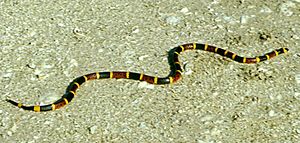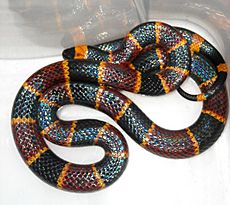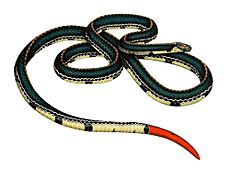Coral snake facts for kids
Quick facts for kids Coral snake |
|
|---|---|
 |
|
| Coral snake (Micrurus sp.) | |
| Scientific classification | |
| Kingdom: | |
| Phylum: | |
| Class: | |
| Order: | |
| Suborder: | |
| Family: | |
The coral snakes are a large group of elapid snakes that can be subdivided into two distinct groups, Old World coral snakes and New World coral snakes.
- There are 11 species of Old World coral snake in one genus (Calliophis)
- There are over 65 recognized species of New World coral snakes in three genera (Leptomicrurus, Micruroides, and Micrurus).
Coral snakes have notable red, yellow/white, and black colored banding. Most species of coral snake are small in size. North American species average around 3 feet (91 cm) in length, but specimens of up to 5 feet (150 cm) or slightly larger have been reported. Aquatic species have flattened tails acting as a fin, aiding in swimming.

Like all elapid snakes, coral snakes possess a pair of small fangs to deliver their venom (some coral snakes are rear fanged). These fangs, which are enlarged and hollow, deliver their venom to their prey species, feeding mostly on smaller snakes, lizards, frogs, and nestling birds and rodents, etc. The venom takes time to take full effect.
Coral snakes often hold on to a victim when biting, unlike vipers. Vipers have retractable fangs and tend to prefer to strike and let go immediately. Coral snakes are not aggressive or prone to biting. They account for less than one percent of the number of snake bites each year in the United States.
Coral snakes in the U.S.A.
New World coral snakes live in the southern range of many temperate U.S. states. They are found in the southern coastal plain from North Carolina to Louisiana, including all of Florida.
There is debate about whether the Texas coral snake is a separate species. Its habitat, in Texas, Louisiana, and Arkansas, is separated from the eastern habitat by the Mississippi River. The coral snake population is most dense in the southeast United States, but coral snakes have been spotted as far north as Kentucky.
The Arizona coral snake, which is a separate genus, is found in central and southern Arizona, extreme southwestern New Mexico and southward to Sinaloa in western Mexico. It lives in dry regions in thornscrub, desert-scrub, woodland, grassland and farmland. It is found in the plains and lower mountain slopes from sea level to 5800 feet (1768 m); often in rocky areas.
Images for kids
See also
 In Spanish: Serpiente de coral para niños
In Spanish: Serpiente de coral para niños



